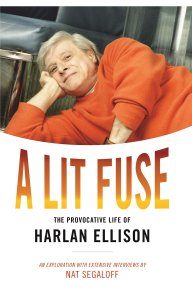Paul Di Filippo Reviews The Oppenheimer Alternative by Robert J. Sawyer
 The Oppenheimer Alternative, Robert J. Sawyer (Arc Manor/Caezik SF & Fantasy 978-1-64710-013-1, $16.99, 374pp, trade paperback) June 2020.
The Oppenheimer Alternative, Robert J. Sawyer (Arc Manor/Caezik SF & Fantasy 978-1-64710-013-1, $16.99, 374pp, trade paperback) June 2020.
The vast, ineluctable, ineffable reality of World War II has provided infinite substance for fiction writers from 1939 to the present. It seems doubtful that the material will ever be exhausted. Like the earlier Victorian period (the still essential and tangible reality of which fuels steampunk), the WWII era is the soil and compost in which our current era has its roots. Trying to grok WWII is really an effort to grok the present.
Alternate history stories that grapple with this era (an era still within living memory, but losing first-hand participants to death every day) are particularly poignant and illuminating and appealing. The popularity of the TV-version of PKD’s The Man in the High Castle is testament to that allure. And recent novels such as Sharma Shields’ The Cassandra and Gregory Benford’s The Berlin Project further attest to the fertility of the genre.
This last-named novel is particularly relevant to the one under consideration today. Like Benford, Sawyer is going to focus on the Manhattan Project, that legendary secret effort to develop an A-bomb, the very name of which has become shorthand for any desperate, crisis-driven scientific-research-in-hyperdrive. The Manhattan Project remains a resonant “jonbar hinge,” and stands for the moment when humanity perhaps wrote its own ultimate Promethean doom.
But unlike Benford, who chose a “minor” peripheral figure as his viewpoint character, Sawyer goes right for the core participant, J. Robert Oppenheimer—“Oppie” to his friends, that famed physicist-administrator whose sensitivities and intelligence rendered him a heroic yet tragic figure. Oppenheimer will be onstage almost continuously in this narrative, save for a few chapters that divert the point of view to secondary characters for laudable plot advancement. In fact, a notice at the front of the book informs us that “every character in this novel was a real person.” This is a rather brave and uncommon step for historical or alt-historical fiction, which generally likes to invent at least a few figures, so as to afford the author leeway for making exciting stuff up as needed.
But Sawyer instead sets out to limn a vast cast of characters who were all highly brainy and idiosyncratic, and also much documented by historians. Not to keep you hanging, he does a magnificent job. Every individual pops right off the page, fully integrated both into their era and amongst themselves.
We start with a short chapter in the year 1936, allowing us to get familiar with Oppie and meet the star-crossed love of his life, Jean Tatlock. Keep this chapter in mind, as the climax will dovetail with it in an esthetically and dramatically pleasing loop.
We next jump to 1942, and the Manhattan Project is off the ground. Oppie, with his irascible and clever current wife Kitty, must assemble his team and manage not only scientific rivalries and plans, but also governmental demands from the military and security branches. This whole stage calls to mind such fictional archetypes as Campbell’s 1930s team of Arcott, Morey, and Wade, but also post-WWII assemblages like Marvel’s Avengers. “Physicists, assemble!” Thus do we see the feedback cycle from art to life to art and around again.
The next 200 pages or so take us through a vivid rendering of the whole project, which proves to be a combination of Peyton Place and some David Lodge or Kingsley Amis novel of academic infighting, as well as a C.P. Snow-like gritty dissection of the scientific process. We end with the dropping of the bombs on Japan, and wartime victory.
But now comes the twist. A small core of scientists at the Project have serendipitously discovered an astrophysical fact about our solar system that spells literal and unavoidable doom for all humanity—at the end of eight more decades. What’s to be done? Oppie must move to Princeton’s Institute for Advanced Study, Einstein’s refuge, put together a new team, the Arbor Project, and brainstorm the salvation of the species. While the first half of the book covered a modest ten years, the second half of the book, feeling a bit like When Worlds Collide, will leapfrog in jampacked compressed fashion across twenty years, right down to 1967, when things, alas, are not looking so good—until a certain Richard Feynman and Kurt Gödel walk into Oppie’s office…
In this portion, of course, Sawyer is now inventing action and dialogue, but he extrapolates linearly from what has gone before, extending all the feuds and friendships in logical, believable ways. History outside the IAS continues more or less unchanged—JFK is assassinated, the Apollo program commences, etc.—which seems reasonable, given the cloistered and hidden actions of Project Arbor that do not leak out to influence the mass of citizens. One pivotal affair that still happens is Oppie’s crucifixion by legislative agencies, on his tail for his old Communist leanings and connections. This incident is handled with a true wealth of feeling.
And in fact the whole book is rich in emotional depth. The last four chapters in particular, almost John Crowleyesque, are a poignant yet hopeful conclusion to Oppenheimer’s long, partly-selfless, partly-egocentric journey.
Ultimately, aside from the touching human drama, this novel is an exploration of the role of science in history and public affairs. As physicist Leo Szilard says towards the end: “The period following World War II was the first time ever that scientists…had been seen as responsible for a turning point in history… [We] scientists were embraced as public intellectuals. What we said about policy was given as much weight as what we said about physics. We were heard.”
And thus this fine novel makes explicit its relevance to the present. Would that scientists were heard once again.
 While you are here, please take a moment to support Locus with a one-time or recurring donation. We rely on reader donations to keep the magazine and site going, and would like to keep the site paywall free, but WE NEED YOUR FINANCIAL SUPPORT to continue quality coverage of the science fiction and fantasy field.
While you are here, please take a moment to support Locus with a one-time or recurring donation. We rely on reader donations to keep the magazine and site going, and would like to keep the site paywall free, but WE NEED YOUR FINANCIAL SUPPORT to continue quality coverage of the science fiction and fantasy field.







Thank you for the hopeful review!
I just got it, and looking forward to read it. Sawyer is one of the few modern SF writers who come from a non-natural science background, but is very good at picturing how science and research works.